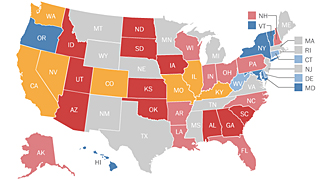WASHINGTON – The enormous cache of secret war logs disclosed by the WikiLeaks website paints a picture of an Iraq burdened by persistent sectarian tension and meddling neighbors, suggesting that the country could drift into chaos once U.S. forces leave.
The reports, covering early 2004 to Jan. 1, 2010, help explain why Iraq's struggle to create a unified, independent state continues, despite a dramatic reduction in violence. They appear to support arguments by some experts that the U.S. should keep thousands of troops there beyond their scheduled departure in 2011, to buy more time for Iraq to become stable.
The threats described in the leaked documents come from outside, including next-door Iran, as well as inside, in the form of sectarian, political and even family rivalries that predate the 2003 American-led invasion and endure today.
The reports demonstrate the weakness of Iraq's civic institutions, court system and military, even before sectarian violence exploded in 2006-2007.
In the fall of 2005, the U.S. military discovered evidence of plots to assassinate various officials, including an Iraqi Army colonel. In September, one of the war logs said, a group of judges was abducted in Balad, beaten and forced into the trunk of a car.
Another example: On June 6, 2006, U.S. forces reported discovering large amounts of blood on the floor, a rubber hose and electric wires rigged to a metal door in a holding cell in an Iraqi police station in Husaybah, in western Iraq.
The report called the discoveries "evidence of unchecked torture" and "clear indications" of human rights violations.
Should WikiLeaks be subject to U.S. state secrets enforcement? |
The U.S. report said that for a time, U.S. military advisers slept in the police station to make sure prisoners were not abused, checked arrest logs and counseled Iraqi police, warning them against these practices.
But even a program of training and counseling didn't put an end to the abuses. According to a report dated Feb. 16, 2009, U.S. forces reported the mistreatment of 33 detainees in custody at the same police station.
The Associated Press was given access to a redacted WikiLeaks database hours before its general release Friday, but was not provided the raw data. The documents appear to be authentic, but their origin could not be confirmed independently.
The leaked war logs reflect significant progress as well. There has been a dramatic improvement in security since the height of the violence in 2006-07, due to a weakened threat from al-Qaida and an Iraqi population weary of the sectarian bloodletting that once threatened to plunge the country into civil war.
Even so, some experts question whether the fledgling military and police forces are capable of defending Iraq after Washington completes its scheduled pullout Dec. 31, 2011.
Those who hold these pessimistic views also worry Iraq could repeat its history of turning to a military dictator in the mold of Saddam Hussein.
Ryan Crocker, ambassador to Iraq in 2007-08, said Washington has decided to turn the page on Iraq but must not close the book.
"We're still very much at the beginning of this story, or more to the point, the Iraqis are at the beginning of their new narrative in their history, and for all of the extraordinary achievements that we've seen, the list of challenges is even greater," he said Friday.
One major challenge is the country's political paralysis. Iraqi politicians are struggling to form a new government seven months after a national election failed to produce a clear winner. That's a symptom, to some, of the country's stubborn religious and ethnic schisms.
Prime Minister Nouri al-Maliki's opponents said the WikiLeaks documents showed he must be stopped from consolidating power. Al-Maliki's office responded by saying the document leak was timed to sabotage his re-election hopes.
Crocker called it "profoundly important" that the U.S. maintain a military presence in Iraq beyond 2011, despite America's weariness with the long and costly war and pressure to shift more resources to Afghanistan.
The leaked documents posted by WikiLeaks recount Iran's role in arming and training Shiite militia groups and seeking to influence Iraqi politics — a concern that may deepen as American influence in Baghdad wanes.
In Crocker's view, Iraq will struggle for years with profound internal political and social problems. Meanwhile, he said, Iran is in effect telling Iraq: "Looks like the Americans are leaving, and guess what — flash news — we're staying."
Before the U.S.-led invasion, predominantly Arab Iraq was stronger militarily than Persian Iran, an old foe.
Today, due to the U.S. defeat of Saddam's forces and its dismantling of his army, Iran enjoys a vast numerical advantage over Iraq in battle tanks and other weapons of war. Iran is likely to keep that edge for years to come.
Anthony Cordesman, a military analyst at the Center for Strategic and International Studies and a frequent visitor to Iraq, said that it could be another decade before Iraq has an effective air force.
In 2003, Iraq had 2,200 main battle tanks, compared with 1,565 for Iran, Cordesman wrote in a new assessment of Iraq's military. Today, Iran's fleet of main battle tanks has swelled to 1,613 while Iraq's has fallen to 149.
By Cordesman's calculations, Iraq's security forces are going to be much less capable in December 2011 — when the last U.S. troops are scheduled to depart — than was planned when the Bush administration negotiated the withdrawal agreement just two years ago.
___
AP National Security writer Anne Gearan and Associated Press writer Pauline Jelinek contributed to this report.






















 The chair of the WOA, Todd Stordahl, told KING 5 News and MyNorthwest.com he has little choice but to discipline officials who used colored whistles. He claims that letting them continue without punishment would send the wrong message to student athletes.
The chair of the WOA, Todd Stordahl, told KING 5 News and MyNorthwest.com he has little choice but to discipline officials who used colored whistles. He claims that letting them continue without punishment would send the wrong message to student athletes.